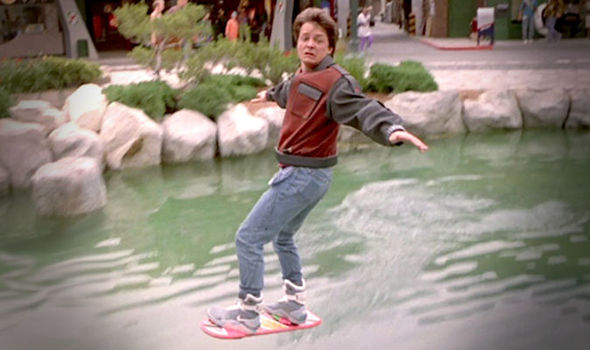retrofuturism?
Retrofuturism (adjective retrofuturistic or retrofuture) is a trend in the creative arts showing the influence of depictions of the future produced in an earlier era. If "futurism is sometimes called a 'science' bent on anticipating what will come, retrofuturism is the remembering of that anticipation." Characterized by a blend of old-fashioned "retro" styles with futuristic technology, retrofuturism explores the themes of tension between past and future, and between the alienating and empowering effects of technology. Primarily reflected in artistic creations and modified technologies that realize the imagined artifacts of its parallel reality, retrofuturism can be seen as "an animating perspective on the world. But it has also manifested in the worlds of fashion, architecture, design, music, literature, film, and video games ("Retrofuturism").
If you explore automobile styles of the mid-1950's-1960's, you might notice a lot of wing shapes and fin shapes and even rocket shapes. This was the era of "mid-century modern"; it was also "the space age." The science of Futurism was incredibly active, as thinkers, seeing what wonders the world was able to produce in the years after WWII, imagined what life might be like in the year 2000 and beyond. Disneyland's Tomorrowland was built around this idea of what will the future be like, and such things as monorails and People Movers do actually exist. Some other ideas (individual flying saucers, for example) have not yet come about, or have they? The Jetsons flying cars of the 1960's are now achievable in both ultra-lights and individual human-carrying drones; robo-cars are not as people imagined them in the 1960's, but there are several functioning driverless cars on American highways as I type this.
So a lot of what people imagined just never has come about (humans colonizing other planets, for example), but some ideas about arts, entertainment, architecture, social structures, technology, housing, vehicles, the workplace, and so on have come about (though often not quite like folks sixty years ago imagined; the classic space station of 2001: A Space Odyssey is not a reality, but the Mir Space Station is still orbiting the earth with its U.S./Soviet astronaut/cosmonaut crews).
imagining life beyond the box
OK, the class theme is "Who took the box?" We know of outliers--the Nikola Teslas and Richard Barnsons of the world who often think outside the box. Some of them (and these two fit this cateegory very nicely) eschew the box altogether; they imagine what boxes might be like generations from now.
Current trends in upcycling, alternative houses, intentional community building, and forward-thinking reseawrch are all non-traditional (they are "different" from what our grandparents did and how they viewed the world. Some are radical departures from convention, and most are acknowledgements that the world is about change. Here's an example:
My first car was a 1959 green Chevy Impala four-door sedan; it was a huge, lumbering boat of a car. Here's a picture of one:
It was under-powered with a small V-8, and with it's mainly-metall construction it was lucky to get 8 miles per gallon of gas. Oh, and by the way, do you notice the tail fins? Those are the "wings" I was referring to above; this was somewhat modeled on a fighter jet (very space-y).
I did not love this car beyond the fact that it represented freedom, mobility, and in the 1960's-1970's California teens "cruised"--we drove to Oxnard for late-night cups of coffee just because we could. We tooled up the coast to camp in Big Sur, spending about $5 round trip on the 25-cents-per-gallon gas at the time. We cruised the Sunset Strip and Hawthorne Blvd. Took summer trips to Canada and, well, wherever.
What we did not know, did not even consider (because is was not part of the mindset of the time) is that we Baby Boomers belched incredible clouds of carbon into the atmosphere and drained off huge amounts of fossil fuels. As far as that generation knew (was told), air pollution was only a mild eye irritant (remember, most people smoked back then), and gasoline was an infinite resource. Who knew?
The 21st-century box [world, social setting/conventions, world view, state of science/technology, culture] is largely a response to the changes the world has experienced from those earlier traditions. Re-using resources, minimazing the human footprint, occupying less space in a continually-expanding population, replacing irreplaceable materials with renewable, hi-tech fabrications, building on technologies that did not even exist in the 1950's--that is outside the box I grew up in.
We were not complete lunkheads. We got some things right. There are communications sattelites and computers, and robotics is both practical and gimmicky in different areas. But much of what we imagined has yet to happen (or is just unlikely to happen based on directions the world has taken) There are, for example, no Earth colonies on other planets. Some new technologies were so far from our then-reality that we just could not predict them.
In 1984, William Gibson wrote a book called Neuromancer, arguably the granddaddy of cyberpunk. In fact, he coined the word "cyberspace" in that novel. The protagonist jacks into computers and travels the electron streams to break through various security systems (there's a lot more to it, but that's a taste), and he is a rogue, a criminal. So even before mainstream personal comupuing, Gibson imagined a world where important transactions would take place in virtual reality, and he gives us an early vision of a hacker. At one point in the story, the main character desperately needs to contact someone. He is running-around the city searching for a coin-op pay phone.
Where is his cell phone? The first mobile phone was invented in the mid-70's (and it was the size of a shoebox). This was a technology many thought would just nevber catch on. So his characters do not have them. They didn't exist, and he didn't imagine they would. Pay phone booths, on the other hand, were widely available in 1984.
sometimes right, sometimes wildly wrong, sometimes...
Here are some pictures from my youth, things that showed what futurists from the 1950's-'70's imagined some of the marvels of the future would be like. Did we get it wrong? Completely?
We were promised personal flying cars and jet packs

And here's a real one-person fllying drone followed by a working jet pack
Here's Marty McFly's flying skateboard from Back to the Future

Well, current hoverboard technology does have some glitches, but they do exist
Computers and robots would control our transportation needs
And, soon, they will
This entertainment gadget just seems preposterous
But is it?
And living in the most unlikely locations was a dream
Or was it?
well, and so what's the point?
We are exploring some of the outlying thinking that drives a lot of the leading-edge trends of the 21st century, but imagine what life might possiblybe like in the 22nd century, in 500 years even. What might housing, entertainment, transportation, commerce, medicine and everything else be like then? We can make some fairly-reasonable guesses based on what is leading edge now, but like William Gibson, we might totally miss that cell phone. And, of course, there are so many unforseeablle possibilities that may change our direction (many times), that even the most probable "things" of the future may just not come to pass.
Who can say? What are your predictions? That will be the subject of this week's class discussion :)

![[schedule]](button12.gif)